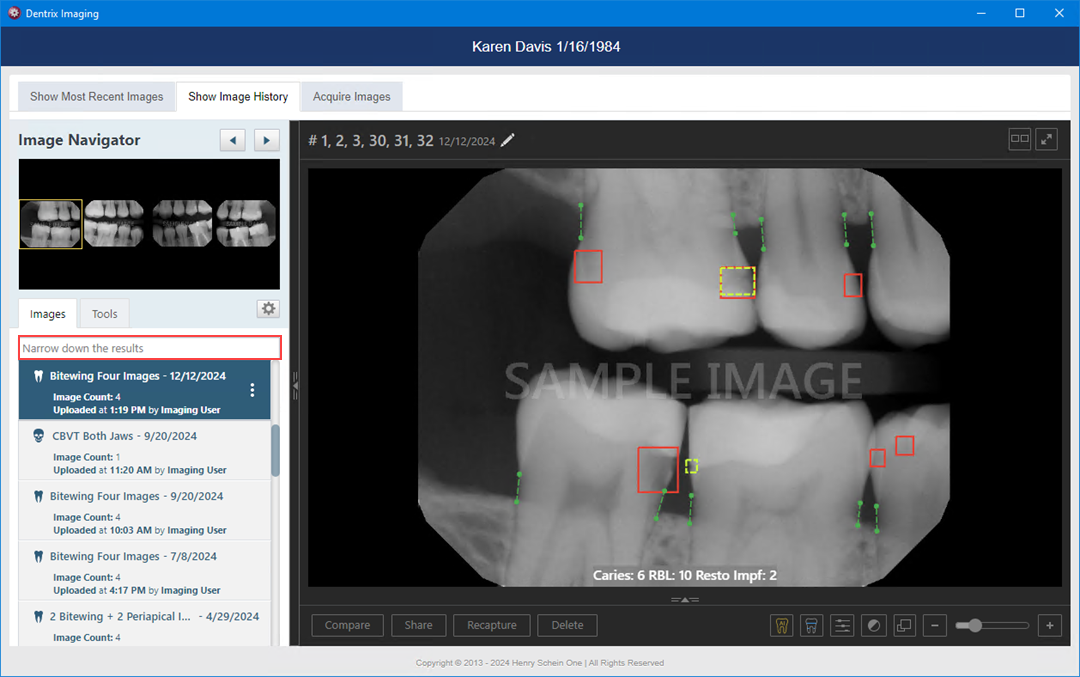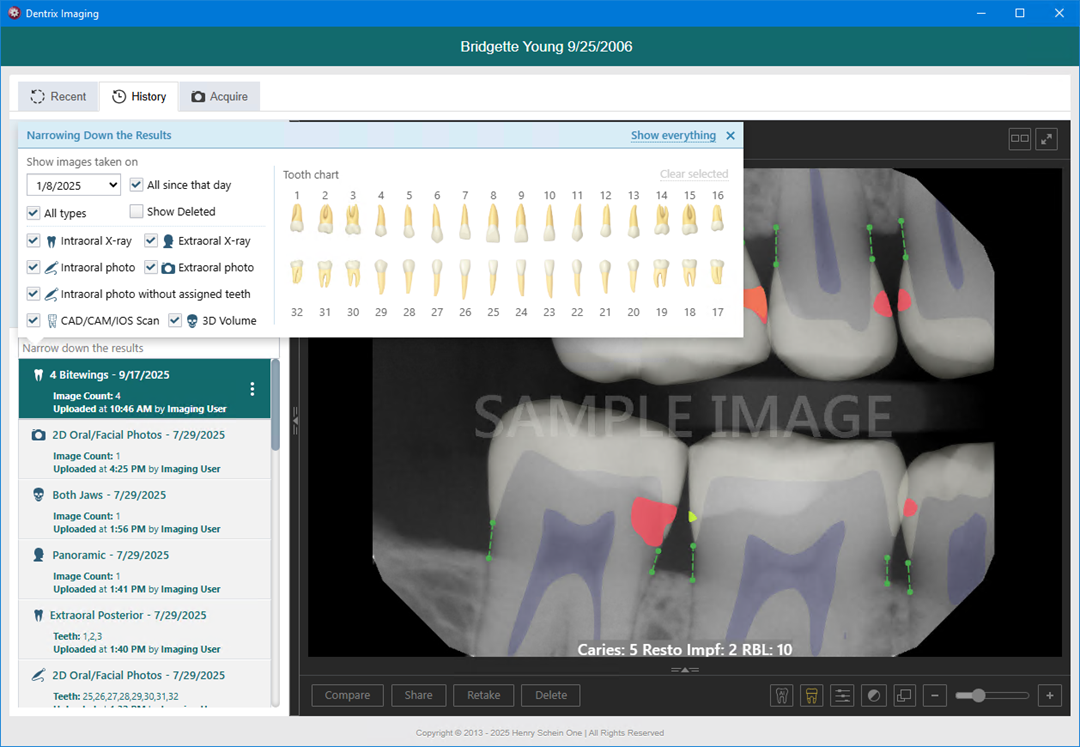

You can view a patient’s entire image history chronologically and quickly navigate between each image. Also, in the history view, you can view individual images larger than you can in the recent images view, and you can process (such as enhance or annotate) an image. For information about using the recent images view, click Viewing recent images. For information about processing images, click Processing images.
To view a patient’s image history
1. In
the Imaging toolbar, click the Launch Dentrix Imaging icon ![]() .
.
The Dentrix Imaging window appears.

2. If needed, filter the list of images on the History tab to display only the images that match the filter criteria that you specify.
a. Click Narrow down the results to view the available filters.

b. Set up any of the following filters:
· Date – To view the images according to a different date, select the desired date in the list under Show images taken on. To view all images that have been acquired on and after the selected date, select the All since that day check box. To view the images that were acquired only on the selected date, clear the All since that day check box.
· Type – To view images in any category (intraoral X-rays, intraoral photos, intraoral photos without tooth numbers assigned, extraoral X-rays, extraoral photos,CAD/CAM scans, and 3D volumes), select the All types check box. To view images in only certain categories, make sure the check boxes of only those categories are selected; the other check boxes must be cleared.
· Teeth – If the Intraoral X-ray and/or Intraoral photo check boxes are selected, to view those types of images for specific teeth, select the desired teeth on the Tooth Chart. The tooth filter does not apply to intraoral photos that do not have tooth numbers assigned to them and extraoral X-rays (which apply to all teeth), and extraoral photos (which apply to all teeth). To clear all tooth selections, click the Clear selected link.
· Show everything – To set the filter options to their default states and display all the patient’s images, click the Show everything link.
The image list displays the images that match your filter criteria.
c. Click the X in the upper-right corner of (or anywhere outside of) the Narrowing Down the Results menu to close the menu.
3. With an image or a series selected, do any of the following:
· Navigate the series – If you have selected a series (such as a full mouth series or bitewings), to navigate between the images of that series, click each image of the series under Image Navigator. A larger version of the current image (highlighted with a yellow box) in the series appears in the viewing area.

Note: You can also click the Previous and Next buttons to navigate between the images in the set.
· Zoom in/out – To increase the zoom level (zoom in), move the Zoom slider to the right. To decrease the zoom level (zoom out), move the slider to the left. If you are using a mouse, you can also zoom in and out by positioning the pointer over the image (the pointer will change to cross hairs) and then rotating the scroll wheel of your mouse.
If you increase the zoom so that the whole image no longer fits in the viewing area, the Pan dialog box appears. Drag the red box around on the thumbnail image in the dialog box to display the area within the red box in the main viewing area.

· Quickly resize – By default, Dentrix Imaging displays images as large as it can in the viewing area. This can cause the images from some older devices or programs to look fuzzy or grainy. To view the image smaller and sharper, click the Smaller/Larger button. The button becomes orange. To view the image as large as it can be and still all fit in the viewing area, click the button again.
Note: The state of the Smaller/Larger button also affects the preview size of images during acquisitions and the size of images in the Image Peek dialog box. The state of the button is stored per computer.
· View full screen – To view the image full screen, click the Full Screen button. To return to the normal view mode, click the Normal Mode button.
Note: The “full screen” view is only as large as the application window.
· View the entire series – If you have selected a series (such as a full mouth series or bitewings), to view all the images in the series at once in the viewing area, click the Series Mode button. Then, to return to the single-image view mode, do one of the following:
· Click an image in the viewing area to view only that image.
· Click an image under Image Navigator to view only that image.

· Click the Single Mode button.
Note: You can zoom in and out while viewing a series.
· View recaptured images – If the image being displayed has been recaptured, View Recaptured is available (as a button or an option on the More button menu).

To view other versions of the image and even choose which one should be active (visible when viewing the exam), either click the View Recaptured button, or select the View Recaptured option on the More button menu. The View Recaptured Images dialog box appears.

The current image appears on the left; other versions, on the right. To navigate between each version, next to Recaptured Image, click the Previous and Next buttons. To use the image being displayed under Recaptured Image instead of the one under Current Image for the exam, click Replace Current.
Note: All original and recaptured images are always stored.
· Re-size a view – (For a 3D volume only)To re-size one of the views (coronal, sagittal, or axial) of the 3D volume to fill the viewing area, click the corresponding Toggle Displaying Full Panel button (outward-pointing arrows on the button indicate the view is normal). To return to the normal view mode, click the Toggle Displaying Full Panel button (inward-pointing arrows on the button indicate the view is expanded).

· Rotate Anatomy – (For a 3D volume only) If the anatomy is crooked, to rotate the plane for a slice view (to move the slice plane axis), in the Coronal, Sagittal, or Axial view box, right-click and drag up or down. The other two views adjust accordingly to the rotation you specify. You can rotate the axis from -45 to +45 degrees about the slice center point.
· Navigating through slices – (For a 3D volume only) To navigate through the slices of the 3D volume, drag the slider next to the Coronal, Sagittal, or Axial view. As you drag the slider, the slice plane indicators (crosshairs) of the other two views adjust accordingly. Drag the sliders of the other views as needed. Alternatively, you can click anywhere on the view to move the slice plane indicators to that spot.

· Changing the slice thickness – (For a 3D volume only) To change the thickness of the slices for the 3D volume, select a different value from the Thickness list: 0.20 mm, 0.60 mm, 0.80 mm, or 1.00 mm.

· Reset the views – (For a 3D volume only) After adjusting the slice plane indicators and/or changing the slice thickness, to return to the default position and thickness, click the Reset Workup button.
· Hide/show the slice plane indicators – (For a 3D volume only) To hide the slice plane indicators (crosshairs) while you are viewing the 3D volume, click the Show/hide slice plane indicators button (yellow on the button indicates they are visible). To view the slice plane indicators, click the Show/hide slice plane indicators button again (gray only on the button indicates they are hidden).
· View the histogram or a rendered 3D image – (For a 3D volume only) By default a histogram appears in the lower-right box. To view a rendered 3D image of the volume (all slices of the volume combined), click the Swap for Volume Render Panel button.

While viewing the rendered 3D image, do the following, as needed:
· To hide the volume plane indicators, click the Show/hide volume plane indicators button (yellow on the button indicates they are visible). To return to viewing the volume plane indicators, click the Show/hide volume plane indicators button again (no yellow on the button indicates they are hidden).
· To rotate the image to view it from the left side, click the Snap to left view button.
· To rotate the image to view it from the right side, click the Snap to the right view button.
· To rotate the image to view it from the front, click the Snap to front view button.
· To return to viewing the histogram, click the Swap for Histogram Panel button.

Important: The ability to render a 3D image and the speed with which it is accomplished depends on the size of the volume and either the onboard graphics processor or the discrete graphics card of your computer. If the image does not render, you may need to upgrade your graphics hardware.
· Saving a snapshot – (For a 3D volume only) To save a copy of the 3D volume as it is currently being viewed as a two-dimensional image (.jpg file) that you can attach to an insurance claim, click Snapshot.